Rise And Shine Adam
Rise and shine Adam
you're probably wondering, where you are?

More Posts from Kitsune-fox-55 and Others
One of my favourite things about Mori and Fyodor projecting onto Dazai is that they keep thinking he's exactly like them when... no??? He's not???? At all??????
Idk maybe I interpret Dazai differently but while Mori and Fyodor are clearly Dazai-foils, I just can't see them as really all that similar.
Sure, strategy-wise, they have a lot in common. They're also all relatively unbound by such things as morality and have few close people - feeling lonely for the most part.
But what gets me is... Mori does what he does because he is an ambitious leader. Fyodor does what he does because he has an ambitious dream. Both are after a way to make the world/city better according to their visions and are prepared to go about darker means to achieve this.
Dazai... doesn't really have any ambitions? They all have eerily similar lines of thinking and ways of dealing with and manipulating situations and people, but their emotional cores are completely different.
Dazai is not ambitious. Dazai is empty. What's more, he's kind of lazy and only really motivated to take action on someone else's requests/orders - otherwise he's actually a really passive character imo. He took orders from Mori in the mafia, only intervened in the DHC because Chuuya got mad, and left the mafia and helps people in the present day because he made a promise to Odasaku. All his strategizing and planning is retaliatory, rather than proactive like Mori or Fyodor. I think the only time we see Dazai planning proactively is in Beast, but even then, that's not some lofty vision for the world/city, that's a desperate plan to save one single person.
This is a huge part of the reason why I think Dazai's threats to kill Mori and take over as the boss were complete bs. Why would he want that? That's more responsibility. I don't see why he would have any desire to lead the mafia outside of Beast.
But because Mori expects Dazai is just like him, and this is something he would do in that situation, he accepts it, putting him and Dazai in this uncomfortable stalemate where neither has complete power over the other. So it has a tactical purpose, yes, but it's far from ambitious.
What's more, Mori and Fyodor are shown to have no compunction with sacrificing people like pawns, even people close to them. Logic wins out, at all costs. Dazai is not good at sacrificing. He's selfish. Once he has something or someone, he's loathe to let it go. If he is significantly close with someone, emotion will actually win out in the end (Odasaku). Dazai is afraid of loss.
So, yeah, they are all amoral brilliant strategists who are isolated from most other people but their motivations are completely different. In all actuality, I think Mori and Fyodor have a lot more in common on that note than Dazai ever did.
I just think it would’ve been cool to have an argument with Joker at some point, especially in ME2. Where is all the tension about him being the reason Shepard stays behind a moment too late in Alchera? Where are Shepard’s feelings about him being all-too-willing to get into the new Normandy? I just think that if you put their survivor guilts and personal crises in the same room for more than 10 minutes you would get something messy and it would be so interesting.


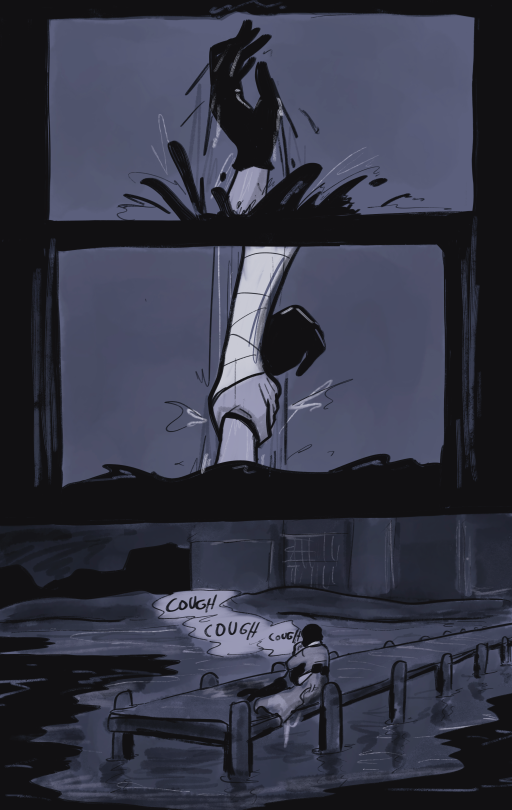
Rest of the comic is under the cut, because LONG :0
Also! Content warnings for body horror, guns, blood(although in black and white) and just...horror in general tbh




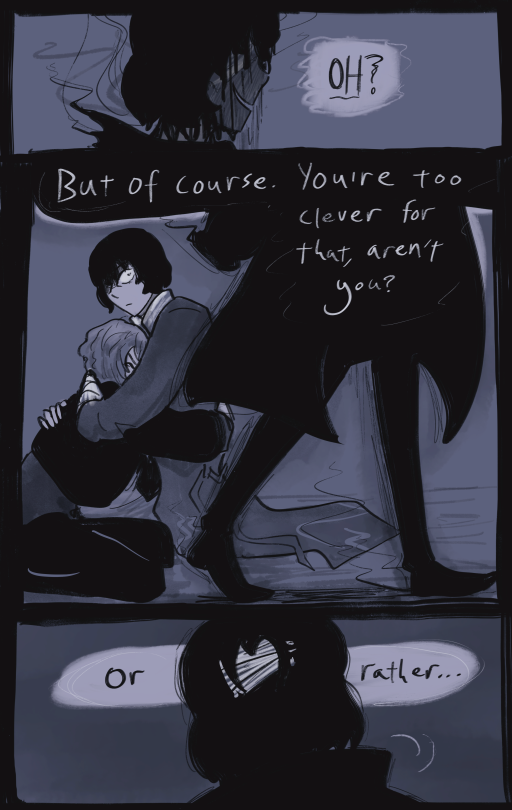

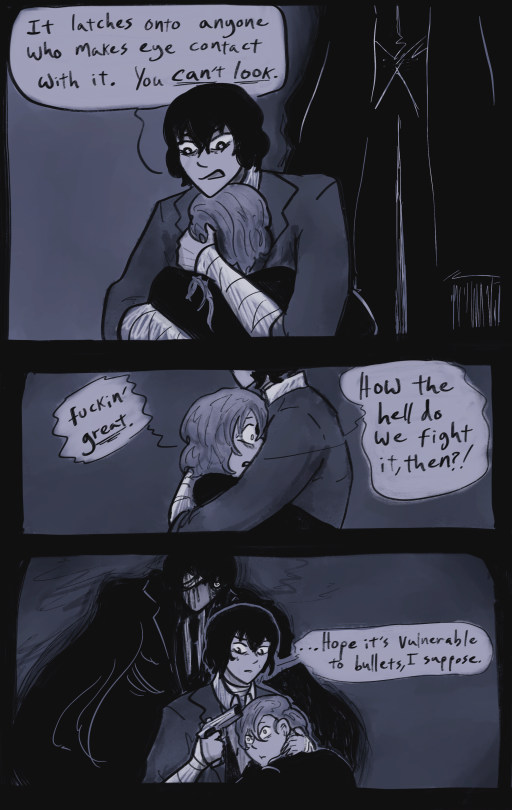



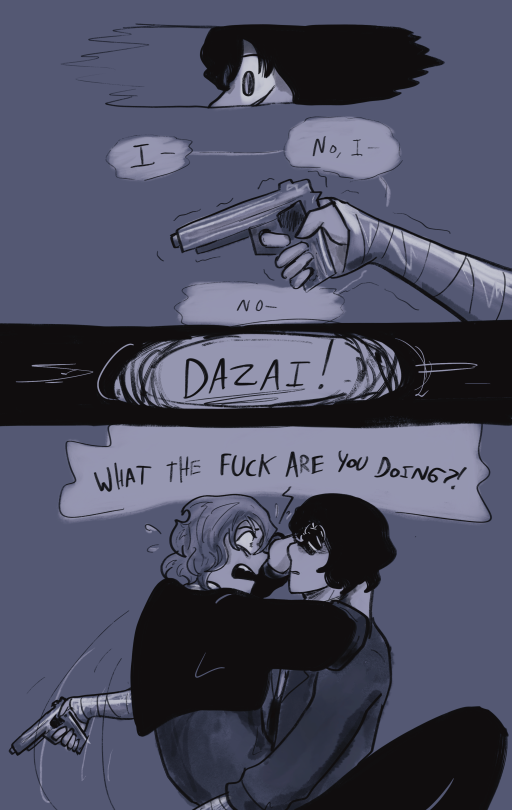


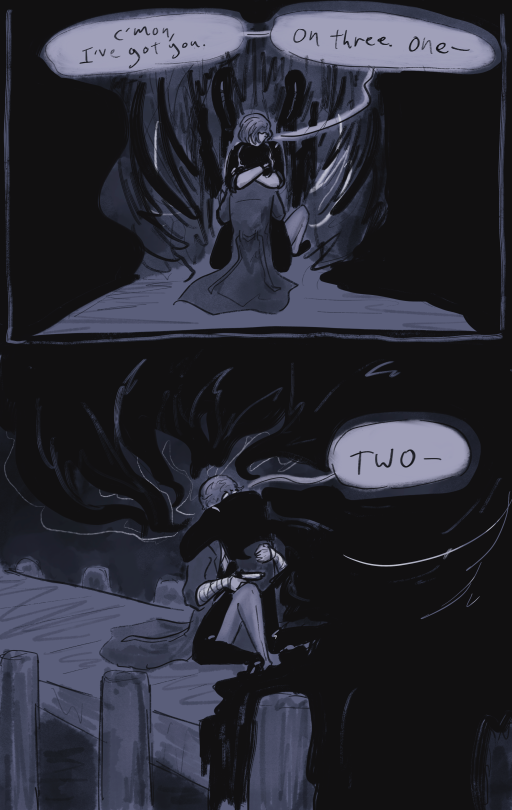



Operation "Fall of the Hooded Hawk": For situations where one half of skk has to shoot without having clear vision, and relies on the direction of their partner. In this case, Chuuya was giving Dazai coordinates of where to fire by tapping against his ear. (It's kind of like a trust fall)
I scripted a whole followup conversation with more explanation of what exactly the mirror was, and just general context, but this comic has gotten so long that I'm gonna write that as a short scene in prose, because it's mostly dialogue and if I try to draw it all then I think my hands will secede from my body lol — I'll probably be able to get that done in the next couple of days. But in the meantime, thanks for reading! :D
(3/5/24 edit: Followup convo is done!)


Cultural Anatomy: Sokka’s Choker
From what I’ve researched, chokers were traditionally worn by some Native American tribes rather than by the Inuit, who traditionally preferred looser fitting necklaces. But Sokka’s particular choker is identical to traditional Alaskan Inuit bracelets, which are made from walrus or whale ivory.

Which means that Sokka might just be wearing a bracelet as a choker. And I can’t think of anything more perfectly Sokka than using an item for something beyond its intended purpose. I can totally imagine how the whole thing started:
Mother Kya: “One day, when Katara gets married, I’ll give her this necklace that Gran-Gran gave to me.”
Lil Sokka: “No fair! Why don’t I get anything?”
Hakoda: “Sokka, this necklace is for girls only.”
Lil Sokka: “Fine, I’ll just make my own necklace.” *ties his bracelet around his neck and immediately starts choking*
Gran-Gran: *sighs* I’ll get more string…
A murder mystery film set in a medieval village. After an outbreak of plague, the villagers make the decision to shut their borders so as to protect the disease from spreading (see the real life case of the village of Eyam). As the disease decimates the population, however, some bodies start showing up that very obviously were not killed by plague.
Since nobody has been in or out since the outbreak began, the killer has to be somebody in the local community.
The village constable (who is essentially just Some Guy, because being a medieval constable was a bit like getting jury duty, if jury duty gave you the power to arrest people) struggles to investigate the crime without exposing himself to the disease, and to maintain order as the plague-stricken villagers begin to turn on each other.
The killer strikes repeatedly, seemingly taking advantage of the empty streets and forced isolation to strike without witnesses. As with any other murder mystery, the audience is given exactly the same information to solve the crime as the detective.
Except, that is, whenever another character is killed, at which point we cut to the present day where said character's remains are being carefully examined by a team of modern archaeologists and historians who are also trying to figure out why so many of the people in this plague-pit died from blunt force trauma.
The archaeologists and historians, btw, are real experts who haven't been allowed to read the script. The filmmakers just give them a model of the victim's remains, along with some artefacts, and they have to treat it like a real case and give their real opinion on how they think this person died.
We then cut back to the past, where the constable is trying to do the same thing. Unlike the archaeologists, he doesn't have the advantage of modern tech and medical knowledge to examine the body, but he does have a more complete crime scene (since certain clues obviously wouldn't survive to be dug up in the modern day) and personal knowledge from having probably known the victim.
The audience then gets a more complete picture than either group, and an insight into both the strengths and limits of modern archaeology, explaining what we can and can't learn from studying a person's remains.
At the end of the film, after the killer is revealed and the main plot is resolved, we then get to see the archaeologists get shown the actual scenes where their 'victims' were killed, so they can see how well their conclusions match up with what 'really' happened.

I am both.
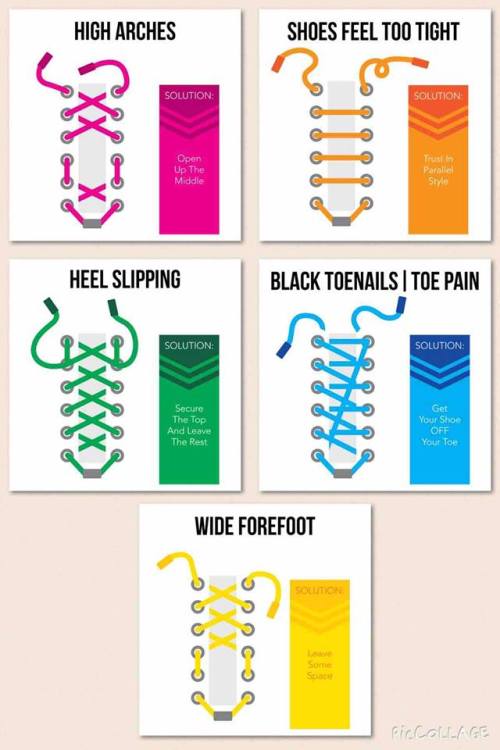
Hey runners (and walkers)! Thought this might be helpful :)
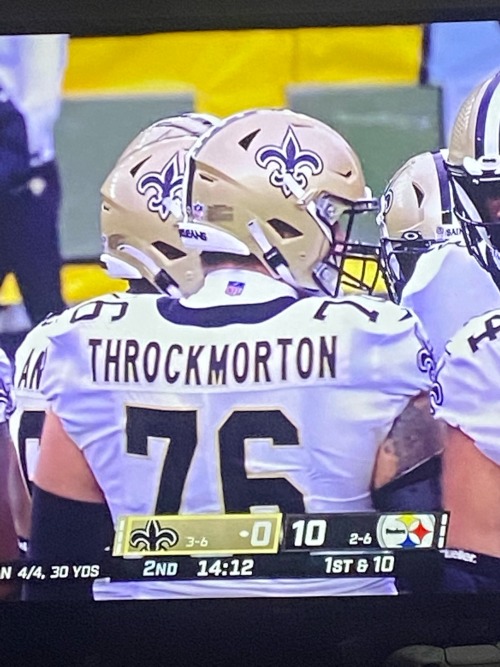
OUR COUSIN MADE IT TO THE NFL
-
 shotgunhobo7 liked this · 1 month ago
shotgunhobo7 liked this · 1 month ago -
 slowtowndun liked this · 1 month ago
slowtowndun liked this · 1 month ago -
 rayitaal liked this · 1 month ago
rayitaal liked this · 1 month ago -
 panconpaltasstuff liked this · 1 month ago
panconpaltasstuff liked this · 1 month ago -
 bed-rotting reblogged this · 1 month ago
bed-rotting reblogged this · 1 month ago -
 rickyyeah06 liked this · 1 month ago
rickyyeah06 liked this · 1 month ago -
 myriadsaxophone liked this · 1 month ago
myriadsaxophone liked this · 1 month ago -
 sc1ssorhandz reblogged this · 1 month ago
sc1ssorhandz reblogged this · 1 month ago -
 hitmewothachair liked this · 1 month ago
hitmewothachair liked this · 1 month ago -
 spookyfattfemme liked this · 1 month ago
spookyfattfemme liked this · 1 month ago -
 idkanymoreidek liked this · 1 month ago
idkanymoreidek liked this · 1 month ago -
 dextermoggin reblogged this · 1 month ago
dextermoggin reblogged this · 1 month ago -
 mx-heinous liked this · 1 month ago
mx-heinous liked this · 1 month ago -
 reptilelube liked this · 1 month ago
reptilelube liked this · 1 month ago -
 infinityonsarah liked this · 1 month ago
infinityonsarah liked this · 1 month ago -
 zombifiedenthusiast liked this · 1 month ago
zombifiedenthusiast liked this · 1 month ago -
 swtorwald liked this · 1 month ago
swtorwald liked this · 1 month ago -
 boyypanties liked this · 1 month ago
boyypanties liked this · 1 month ago -
 straw-outofthecontext liked this · 1 month ago
straw-outofthecontext liked this · 1 month ago -
 mimzy6bunny reblogged this · 1 month ago
mimzy6bunny reblogged this · 1 month ago -
 konekoling liked this · 1 month ago
konekoling liked this · 1 month ago -
 anarcholive liked this · 1 month ago
anarcholive liked this · 1 month ago -
 ah-little-kraken liked this · 1 month ago
ah-little-kraken liked this · 1 month ago -
 raccoonpunk liked this · 1 month ago
raccoonpunk liked this · 1 month ago -
 djinntrouble reblogged this · 1 month ago
djinntrouble reblogged this · 1 month ago -
 djinntrouble liked this · 1 month ago
djinntrouble liked this · 1 month ago -
 eyeless-jeff666 liked this · 1 month ago
eyeless-jeff666 liked this · 1 month ago -
 dreedro liked this · 1 month ago
dreedro liked this · 1 month ago -
 bigbagofhot reblogged this · 1 month ago
bigbagofhot reblogged this · 1 month ago -
 zachariesnackaire liked this · 1 month ago
zachariesnackaire liked this · 1 month ago -
 mjgoblou reblogged this · 1 month ago
mjgoblou reblogged this · 1 month ago -
 xladyvileblood liked this · 1 month ago
xladyvileblood liked this · 1 month ago -
 theoneofwhomisblue liked this · 1 month ago
theoneofwhomisblue liked this · 1 month ago -
 vivilovespink reblogged this · 1 month ago
vivilovespink reblogged this · 1 month ago -
 vivilovespink liked this · 1 month ago
vivilovespink liked this · 1 month ago -
 king-carnivore reblogged this · 1 month ago
king-carnivore reblogged this · 1 month ago -
 king-carnivore liked this · 1 month ago
king-carnivore liked this · 1 month ago -
 transgender-catboy reblogged this · 1 month ago
transgender-catboy reblogged this · 1 month ago -
 transgender-catboy liked this · 1 month ago
transgender-catboy liked this · 1 month ago -
 thefawnbottoms liked this · 1 month ago
thefawnbottoms liked this · 1 month ago -
 upsetokaiba liked this · 1 month ago
upsetokaiba liked this · 1 month ago -
 delicatelluv liked this · 1 month ago
delicatelluv liked this · 1 month ago -
 lynncss liked this · 1 month ago
lynncss liked this · 1 month ago -
 coffee-is-not-coffeeing liked this · 1 month ago
coffee-is-not-coffeeing liked this · 1 month ago -
 imbr0ke liked this · 1 month ago
imbr0ke liked this · 1 month ago -
 akwardio liked this · 1 month ago
akwardio liked this · 1 month ago -
 theresgoingtobeaflood reblogged this · 1 month ago
theresgoingtobeaflood reblogged this · 1 month ago -
 theresgoingtobeaflood liked this · 1 month ago
theresgoingtobeaflood liked this · 1 month ago -
 placeboqueen liked this · 1 month ago
placeboqueen liked this · 1 month ago -
 cinemaminx liked this · 1 month ago
cinemaminx liked this · 1 month ago
